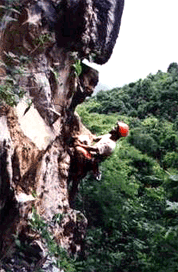Mountain Techniques Page
This page will contain Mountain Adventure Techinques for our guest, hopfully they might help to develop your adventure skills and techniques. Also if our guest have some ideas and useful techniques, This page all welcome to put in for all adventurers.
Rock Climbing
1. Warm-up - Warm muscles can stretch further and react faster. Flexibility is one of the most important aspect of developing technique, not only dose it widen your movement options, it decreases the chance of injury. TIPS: Stretches should be maintained for at least 30 seconds, a minute is better.
2. Develop a positive attitude - Climbing is a strategic sport, a kind of vertical chess board. If your mind isn't positive, tuned up and open, you're not going to climbing well. Before you reach for the first hold, clear your mind of the everyday clutter and be prepared to think outside the square. Is that obvious next move really the best one?
3. Plan your route - Every climbing route designed for climb so think about the way you will go from the base. Start by planing a movement series of two, three or even four.
4. Think with your feet - We're not used to talking much notice of what our feet are doing! And when you're climbing, your hands are right there in front of your face and what about your feet? Most of the technique in climbing is in your lower body. Think about your feet, stand on them and use them. Keeping your hips over your feet and as close to the wall when possible will keep you stable.
5. Choose the best grip - The right hand technique makes hanging on less tiring. Difference techniques work on difference holds. For example, on edges, your could choose either and open-hand grip or crimp grip. Experiment and see what work for you.
6. Use the front of your feet - Good climbers are more likely to use the section of the foot from the front of the arch to the tip of the toes to contact the holds. This allows them extra reach if they need by extending the ankle.
7. Place your feet with precision - Try to place your feet smoothly on hold once and watch it until you get the next one, Try not to place, replace and bounce it or shuffle it around aim for purposeful movement.
8. Transfer your weight smoothly - Place your foot on the hold, transfer the weight onto it and then stand up using your strong leg muscles, keeping your hips close to the wall. Beginners tend to place their foot and try to step up on it straightaway, which can be unstable and puts more strain than is necessary on the arms.
9. Very the direction of your feet - Experiment with the direction of your feet placement to give you more chance to reach to the next hole.
10. Use your reach - A straight arm uses much less energy to hang from. Can't reach that hold? Use the extra extension your shoulder offers to make the most of your arm length, You'd surprised how many people don't think of it.
Enjoy the climb!!!
Abseiling Technique
The perfect position: going down
The perfect position is a high anchor for easy take-off, a smooth slap where you can see all the way down and one where you can easily retrieve your rope. This is the idea for beginnet but as you become more experienced you're more likely to enjoy the challenge of the steeper or overhanging face. As with all rock climbing situation, the anchor must be 100 per cent secure. If it isn't don't abseil. As in belaying, there is a live rope and dead rope. The live rope is that below the abseil device. Keep the feet sholder width apart, turn slightly to the right if you're right-handed and watch where you're going. The difficult part is committing yourself to the abseil but, having done that , just feed the rope out at the same speed while walking backwards down the crag. The closer you can get to the horizontal, the less likely your feet are to slip, so lean back, flex the knees and control the live rope with your lower hand. There should also be srparate safty rope or backup just in case.
Top Tips Abseiling
- Make sure your ropes reach the ground, or least another stance.
- Get a sound anchor, at any price.
- Practise and become familiar with the technique you are using.
- Keep your anchor as hight as possible in relation to where your take-off point is.
- Use a french prussik from your leg loop, and make sure it is the right length. This is usually a 1.5 metre (4 foot) length of 6 mm.cord joined with a double fisherman's knot or an overhand knot.
- Where multipitch abseils are involved, have a sling sucurely attached to your harness so you can clip on to the anchor on arrival at the next stance before unclipping from the rope.
- Don't use trees unless you really have to, and then leave a sling or length of tape.
- Back the an chor up if in doubt.
- Buy yourself a million if your harness is type that requires holding together at your front.



